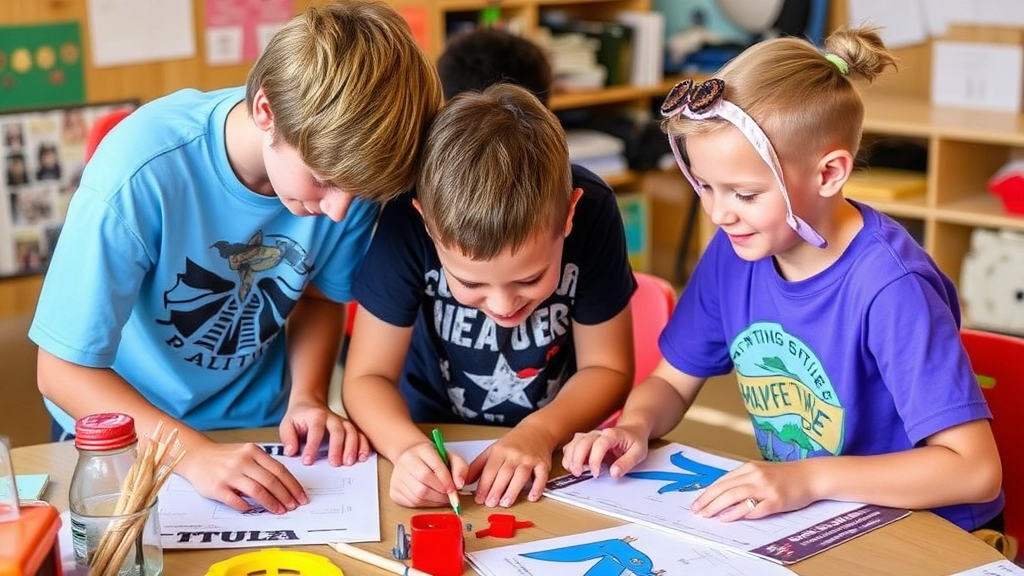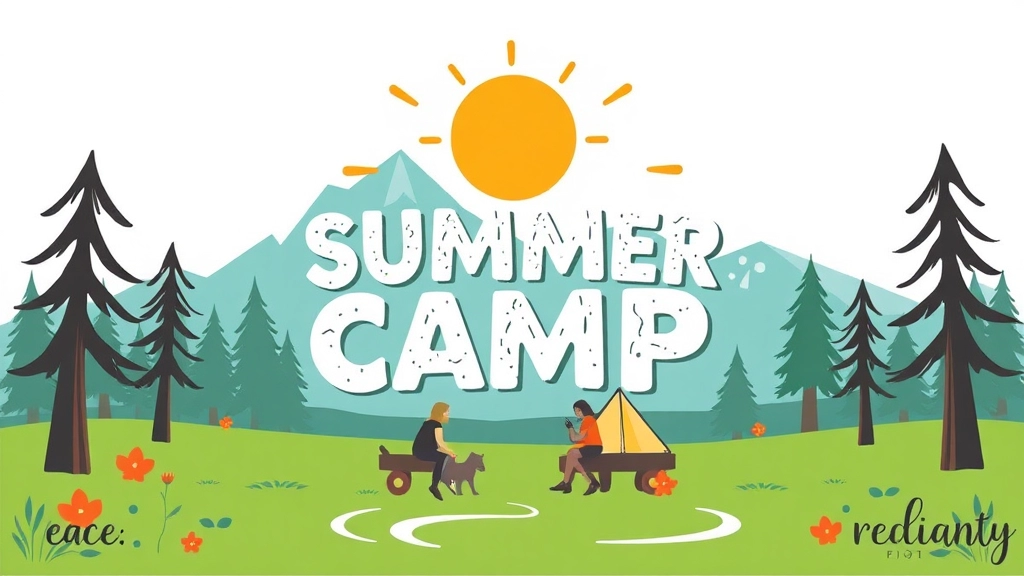Unlock Your Teen’s Creative Potential This Summer
Are you ready to unlock your teen’s creative potential this summer? Welcome to our comprehensive guide on graphic design summer camps! From understanding the different types of camps to exploring the key skills taught, this article covers it all. We’ll dive into the benefits of learning graphic design at a young age, compare virtual and in-person camps, and even share success stories of teens who found their passion in design. Whether your teen is a beginner or an advanced designer, there’s a camp out there that’s perfect for them.
We’ll also tackle practical considerations like cost and financial aid options, how to choose the best camp, and the top software tools used in these programs. Plus, we’ll discuss the role of graphic design in other creative industries and the various career paths available for budding designers. So, if you’re curious about how graphic design camps can foster creativity, collaboration, and real-world skills, keep reading. Your teen’s journey to becoming a skilled graphic designer starts here!
Types of Graphic Design Summer Camps
You’ve probably heard about graphic design summer camps, but what’s the deal with them? Are they worth it? Let’s dive in and see what types are out there.
What Are Graphic Design Summer Camps?
First off, graphic design summer camps are a fantastic way for teens to dive into the world of design. They offer hands-on experience, and there are different types to fit various interests and skill levels.
Beginner Camps
Worried about starting from scratch? Beginner camps are perfect for those who are just dipping their toes into graphic design. They cover the basics like:
- Colour Theory
- Typography
- Basic Software Skills
These camps are all about building a solid foundation.
Advanced Camps
Already got some skills? Advanced camps take it up a notch. They focus on:
- Complex Projects
- Advanced Software Techniques
- Portfolio Development
These are ideal if you’re looking to refine your skills and create a killer portfolio.
Specialised Camps
Got a niche interest? Specialised camps focus on areas like:
- Web Design
- Animation
- Illustration
These camps let you explore specific fields within graphic design.
Virtual Camps
Can’t travel? No worries. Virtual camps offer flexibility and convenience:
- Learn from Home
- Access to Digital Resources
- Interactive Online Sessions
These camps make it easy to fit learning into your schedule.
In-Person Camps
Prefer face-to-face interaction? In-person camps provide:
- Hands-On Workshops
- Networking Opportunities
- Direct Feedback from Instructors
These camps are great for those who thrive in a collaborative environment.
Why Choose a Graphic Design Camp?
Graphic design summer camps aren’t just about learning new skills. They’re about discovering your passion, meeting like-minded people, and setting the stage for future career opportunities. Whether you’re a beginner or a budding expert, there’s a camp that’s perfect for you.
If you’re interested in exploring other types of camps, check out the top summer camps for teens or learn about the ultimate guide to choosing a cheer summer camp.
Key Graphic Design Skills Taught at Summer Camps

Wondering what skills your teen will pick up at a graphic design summer camp?
Let’s dive in.
1. Basic Design Principles
First off, they’ll learn the basics.
- Colour Theory: How different colours work together.
- Typography: Choosing the right fonts.
- Layout: Arranging elements on a page.
These are the building blocks.
2. Software Proficiency
Kids get hands-on with top graphic design software.
- Adobe Photoshop: For image editing.
- Illustrator: For vector graphics.
- InDesign: For layout design.
Learning these tools is a game-changer.
3. Digital Illustration
Creating digital art from scratch.
They’ll use tablets and styluses.
4. Branding and Logo Design
They’ll learn how to create logos and brand identities.
This is huge for anyone looking to go pro.
5. UX/UI Design
User Experience and User Interface.
They’ll design websites and apps that are both beautiful and functional.
6. Creative Problem-Solving
Graphic design isn’t just about making things look good.
It’s about solving problems visually.
7. Portfolio Development
By the end of the camp, they’ll have a solid portfolio.
This is crucial for college applications and future jobs.
8. Collaboration and Feedback
Working with others.
Giving and receiving constructive criticism.
This is how real-world projects get done.
9. Time Management
Deadlines are a big deal in design.
They’ll learn to manage their time effectively.
10. Presentation Skills
Pitching their ideas.
Presenting their work.
This builds confidence and communication skills.
In a nutshell, these camps are more than just fun.
They’re a stepping stone to a future in graphic design.
Ready to see your teen thrive?
Sign them up for a graphic design summer camp.
It’s an investment in their future.
Virtual vs. In-Person Graphic Design Camps: Pros and Cons
So, you’re thinking about sending your teen to a graphic design camp, but you’re stuck between virtual and in-person options. Trust me, you’re not alone. This is a big decision. Let’s break it down and make it simple.
Benefits of Learning Graphic Design at a Young Age

Why should kids dive into graphic design early?
Let’s get real. Kids today are growing up in a digital world.
They’re glued to screens, and not just for games. They’re creating, sharing, and consuming content like never before.
So, why not channel that screen time into something productive?
Here’s the deal:
Learning graphic design young can be a game-changer.
Here’s why:
Boosts Creativity
Graphic design is all about creativity.
Kids get to play with colours, shapes, and fonts. They learn to think outside the box.
And let’s face it, who doesn’t want their kid to be more creative?
Improves Problem-Solving Skills
Design isn’t just about making things look pretty.
It’s about solving problems.
Kids learn to tackle design challenges head-on. They figure out what works and what doesn’t.
It’s like a brain workout, but fun.
Enhances Tech Skills
Kids are already tech-savvy.
Graphic design takes it up a notch.
They’ll get hands-on with tools like Photoshop and Illustrator.
By the time they’re teens, they’ll be pros.
Builds Confidence
Creating something from scratch and seeing the final product?
That’s a confidence booster.
Kids feel proud of their work. They get to showcase their designs and get feedback.
It’s a great way to build self-esteem.
Opens Career Doors
Starting early means more time to master the craft.
By the time they hit university, they’ll have a killer portfolio.
Graphic design isn’t just for artists. It’s a skill that’s in demand across industries.
Encourages Collaboration
Graphic design camps often involve group projects.
Kids learn to work together, share ideas, and give constructive feedback.
These are skills that’ll serve them well in any career.
Real Talk:
I’ve seen kids go from doodling in notebooks to designing logos for local businesses.
It’s amazing what they can achieve when they start young.
Quick Recap:
- Creativity: Unleash their inner artist.
- Problem-Solving: Design is more than aesthetics.
- Tech Skills: Master the tools of the trade.
- Confidence: Create, showcase, and shine.
- Career Opportunities: Build a future-proof skill set.
- Collaboration: Learn to work as a team.
So, if you’re wondering whether to sign your kid up for a graphic design camp, the answer’s a no-brainer.
It’s a yes.
Trust me, they’ll thank you later.
Ready to get started?
Check out our list of top graphic design summer camps and find the perfect fit for your young designer.
Top Graphic Design Software Tools Used in Summer Camps
Alright, let’s talk about the top graphic design software tools used in summer camps. If you’re a parent or a teen, you might be wondering, “What software will my kid actually be using?” or “Is this stuff any good?” Well, let’s break it down.
The Big Players
When it comes to graphic design, there’s a handful of software that dominates the scene. These tools are not just popular; they’re industry standards. Here’s the lowdown:
-
Adobe Photoshop
- Why it’s a big deal: Photoshop is the go-to for photo editing and manipulation. It’s versatile and powerful.
- What kids learn: Basic to advanced photo editing, retouching, and creating composite images.
- Pro tip: Mastering Photoshop can open doors to various creative fields, not just graphic design.
-
Adobe Illustrator
- Why it’s a big deal: Illustrator is perfect for creating vector graphics. Think logos, icons, and illustrations.
- What kids learn: Vector drawing, typography, and logo design.
- Pro tip: Vectors are scalable without losing quality, making this skill super valuable.
-
Adobe InDesign
- Why it’s a big deal: InDesign is the king of layout design. It’s used for everything from brochures to eBooks.
- What kids learn: Page layout, text formatting, and creating multi-page documents.
- Pro tip: Knowing InDesign is a must for anyone looking to get into print or digital publishing.
-
Canva
- Why it’s a big deal: Canva is user-friendly and perfect for beginners. It’s a drag-and-drop tool that makes design accessible.
- What kids learn: Basic design principles, social media graphics, and simple layouts.
- Pro tip: Canva is great for quick projects and social media posts.
-
Sketch
- Why it’s a big deal: Sketch is a favourite among UI/UX designers. It’s streamlined for web and mobile design.
- What kids learn: Interface design, prototyping, and wireframing.
- Pro tip: If your teen is interested in app or web design, Sketch is a must-have skill.
Why These Tools Matter
Now, you might be thinking, “Why should my kid learn these specific tools?” Here’s why:
How Graphic Design Camps Encourage Creativity and Collaboration

Ever wonder how graphic design camps spark creativity and teamwork in teens?
Let’s dive in.
Graphic design camps are all about pushing boundaries and thinking outside the box.
Why Creativity Matters
First off, creativity isn’t just about making things look pretty.
It’s about problem-solving.
It’s about thinking differently.
And guess what?
Graphic design camps are designed to do just that.
How Camps Boost Creativity
- Diverse Projects: Teens work on everything from logos to posters.
- Creative Challenges: Daily tasks that push them to think on their feet.
- Guest Speakers: Pros from the industry share their journeys and tips.
Collaboration is Key
Now, let’s talk teamwork.
Design isn’t a solo gig.
It’s all about bouncing ideas off others.
Ways Camps Foster Collaboration
- Group Projects: Teens team up to tackle projects together.
- Peer Reviews: They get feedback from their peers, not just instructors.
- Brainstorming Sessions: Open forums where everyone pitches in ideas.
Real-World Scenarios
Imagine working on a real client project.
That’s what some camps offer.
Teens get a taste of real-world deadlines and client demands.
Benefits of Collaboration
- Better Ideas: More minds mean more creativity.
- Learning from Others: Teens pick up new skills from their peers.
- Building Networks: They make connections that could last a lifetime.
Stories from the Campfire
Take Jamie, for instance.
He started off shy, unsure of his skills.
By the end of camp, he was leading a team project.
Or Sarah, who discovered her passion for typography through a group challenge.
Why It Matters
At the end of the day, it’s not just about learning software.
It’s about becoming a better thinker and team player.
Graphic design camps make that happen.
Hands-On Projects to Expect at Graphic Design Camps
Ever wondered what kind of hands-on projects you or your teen might dive into at a graphic design summer camp? Let’s cut to the chase and break it down.
Real Questions, Real Worries
- “Will I actually create something cool?”
- “Is it just theory, or do we get to make real stuff?”
These are the burning questions on everyone’s mind. Let’s get into it.
The Meat and Potatoes of Graphic Design Camps
Hands-on projects are the lifeblood of any good graphic design camp. Here’s what you can expect:
Logo Design
- Why it matters: Every brand needs a logo. It’s the face of the company.
- What you’ll do: Create a logo from scratch, often for a mock company. You’ll learn about colour theory, typography, and how to make something that stands out.
Poster Creation
- Why it matters: Posters are everywhere â concerts, movies, events.
- What you’ll do: Design a poster for an event or a cause. This project teaches layout design, image manipulation, and how to convey a message visually.
Digital Illustrations
- Why it matters: Illustrations can make or break a design.
- What you’ll do: Use software like Adobe Illustrator to create digital art. This helps you understand vector graphics and the importance of scalability in design.
Website Mockups
- Why it matters: Almost every business needs a website.
- What you’ll do: Design a website layout using tools like Adobe XD or Figma. You’ll learn about user experience (UX) and user interface (UI) design.
Social Media Graphics
- Why it matters: Social media is a huge part of marketing today.
- What you’ll do: Create graphics for platforms like Instagram or Facebook. This project focuses on quick, eye-catching designs that grab attention.
Breaking It Down
- Logo Design: Learn to create a brand’s face.
- Poster Creation: Master visual communication.
- Digital Illustrations: Dive into vector graphics.
- Website Mockups: Get a grip on UX/UI.
- Social Media Graphics: Craft engaging online content.
Keep It Real, Keep It Fresh
Here’s the deal: these projects aren’t just busywork. They’re designed to make you think like a real designer. You’ll get feedback, iterate on your designs, and see real improvement. And trust me, there’s nothing like the feeling of seeing a finished project that you created from scratch.
Story Time
I remember one student who came in with zero experience. By the end of the camp, they had created a stunning logo and a full set of social media graphics for a mock brand. That’s the kind of transformation we’re talking about.
Why It Matters
These hands-on projects aren’t just about learning tools and techniques. They’re about building a portfolio, gaining confidence, and discovering a passion for design. And who knows? These projects might just be the first step towards a career in graphic design.
Ready to get started? Check out our other sections on Theater Camps for Kids and Teens and Art Summer Camps to find the perfect fit for you.
Career Paths for Teens Interested in Graphic Design

Ever wonder what you can do with graphic design skills?
Let’s break it down.
1. Graphic Designer
This is the obvious one, right? You create visuals for websites, ads, magazines—you name it.
2. Web Designer
Love the internet? Web designers make websites look awesome and user-friendly.
3. UX/UI Designer
Ever get frustrated with a confusing app? UX/UI designers fix that by making apps and websites easy to use.
4. Animator
Like cartoons or animated movies? Animators bring characters and stories to life.
5. Branding Specialist
Love logos and brand identities? Branding specialists shape how companies look and feel to the public.
6. Art Director
Want to lead a creative team? Art directors oversee the visual aspects of projects from start to finish.
7. Freelance Designer
Want to be your own boss? Freelancers work on various projects for different clients.
8. Print Designer
Still love the feel of paper? Print designers create everything from posters to book covers.
9. Social Media Manager
Can’t get enough of Instagram? Social media managers create content that grabs attention online.
10. Game Designer
Into video games? Game designers create the visual elements of games.
Real Stories, Real Success
Take Sarah, a teen who attended a summer camp and now works as a UX designer at a top firm.
Or Jake, who turned his love for animation into a career at a major studio.
Why It Matters
Graphic design isn’t just a skill; it’s a gateway to multiple careers.
The sooner you start, the better.
Locations Offering Graphic Design Summer Camps
Looking for the best spots for graphic design summer camps? Finding the right location can be a game-changer. Let’s dive into where you can send your teen to unleash their creativity.
Why Location Matters
Choosing the right place for a graphic design camp isn’t just about convenience. It’s about the environment, the vibe, and the opportunities available. Here’s what to consider:
- Proximity to Creative Hubs: Cities like London, Manchester, and Edinburgh are buzzing with creative energy. Being close to these hubs can provide inspiration and networking opportunities.
- Access to Resources: Top-notch facilities and resources make a huge difference. Look for camps that boast state-of-the-art equipment and software.
- Community and Culture: A diverse and vibrant community can enrich the learning experience. It’s all about the atmosphere and the people your teen will meet.
Top Locations for Graphic Design Camps
London
London is a powerhouse for all things creative. With a plethora of design studios and galleries, it’s an ideal place for budding designers. Camps here often offer:
- Workshops with Industry Pros: Learn directly from the experts.
- Visits to Art Exhibits: Get inspired by the best in the business.
Manchester
Known for its music and arts scene, Manchester provides a unique backdrop for creativity. Expect:
- Collaborative Projects: Work alongside peers from different backgrounds.
- Hands-on Experience: Real-world projects that make learning exciting.
Edinburgh
Edinburgh’s rich history and vibrant arts scene make it a top choice. Camps here focus on:
- Cultural Immersion: Dive into the local art scene.
- Creative Freedom: Encourage out-of-the-box thinking.
Virtual Options
Not everyone can travel, and that’s okay. Virtual camps bring the experience to your doorstep. Pros include:
- Flexibility: Learn from anywhere.
- Access to Global Experts: Connect with instructors worldwide.
How to Choose the Right Location
When picking a location, consider:
- Interests and Goals: What does your teen want to achieve?
- Budget Constraints: Some locations might be pricier than others.
- Camp Reputation: Research reviews and success stories.
For a comprehensive list of camps that cater to younger children, check out our guide on the best summer camps for 4-year-olds. Additionally, if you’re looking for a broader range of activities, our ultimate summer camp calendar guide is a must-read.
How to Choose the Best Graphic Design Camp for Your Teen

Wondering how to pick the right graphic design camp for your teen? You’re not alone.
Choosing the best camp can feel like a mission. But don’t worry, I’ve got you covered.
What Are Your Teen’s Goals?
First things first.
What does your teen want to achieve? Are they looking to learn the basics or dive deep into advanced techniques? Knowing their goals will help narrow down the options.
Camp Types: Virtual vs. In-Person
Virtual or in-person? Each has its pros and cons.
Virtual Camps:
- Flexibility: No need to travel.
- Comfort: Learn from home.
- Tech-Savvy: Emphasises digital skills.
In-Person Camps:
- Hands-On Learning: Immediate feedback.
- Networking: Face-to-face interactions.
- Immersive Experience: Full focus on learning.
Check the Curriculum
Not all camps are created equal.
Look at the curriculum. Does it cover the key skills your teen wants to learn? Check for:
- Software Training: Adobe Photoshop, Illustrator, etc.
- Design Principles: Colour theory, typography.
- Project Work: Real-world applications.
Instructor Quality
Who’s teaching your teen?
Experienced instructors can make a big difference. Look for:
- Industry Experience: Are they professionals?
- Teaching Style: Do they engage students?
- Reviews: What do past attendees say?
Cost and Financial Aid
Let’s talk money.
Graphic design camps can be pricey. But don’t let that deter you. Many offer financial aid or scholarships. Always check:
- Tuition Fees: What’s included?
- Payment Plans: Are they flexible?
- Financial Aid: Available options.
Location, Location, Location
If you’re opting for an in-person camp, location matters.
Is it close to home? If not, consider:
- Accommodation: Is it provided?
- Travel Costs: How much will it add to the budget?
Reviews and Testimonials
Real feedback from real people.
Check online reviews and testimonials. They offer insights you won’t find in brochures. Look for:
- Success Stories: Teens who found their passion.
- Ratings: Overall satisfaction.
- Detailed Feedback: Pros and cons.
Hands-On Projects
Learning by doing.
The best camps offer hands-on projects. These help teens apply what they’ve learned. Ask about:
- Project Types: What will they create?
- Portfolio Development: Can they build a portfolio?
- Collaborative Work: Will they work in teams?
Cost and Financial Aid Options for Graphic Design Summer Camps
Worried About the Cost of Graphic Design Summer Camps?
Let’s be realâgraphic design summer camps can be pricey. But don’t stress; there are ways to make it work without breaking the bank. First things first, let’s break down what you’re looking at in terms of costs and how you can manage them.
Typical Costs
- Tuition Fees: These can range from a couple of hundred to several thousand pounds, depending on the camp’s duration and prestige.
- Materials and Software: Some camps provide these, while others expect you to bring your own. This can add another £50-£200 to your total.
- Accommodation and Meals: If the camp is residential, expect to pay extra for room and board.
Financial Aid Options
Now, let’s dive into the good stuffâhow you can get financial help.
- Scholarships and Grants:
- Merit-Based Scholarships: These are for students who show exceptional talent or promise in graphic design. Keep an eye on the camp’s website or contact them directly for specific opportunities.
- Need-Based Grants: If your household income is on the lower side, you may qualify for financial aid. Camps often have a limited number of these, so apply early.
- Payment Plans:
- Many camps offer flexible payment plans. Instead of paying a lump sum upfront, you can spread the cost over several months. It’s like breaking down a big project into manageable chunks.
- Early Bird Discounts:
- Sign up early and save. Many camps offer discounts if you register months in advance. It’s a no-brainer if you’re planning ahead.
- Work-Study Programs:
- Some camps offer work-study options where teens can work part-time at the camp in exchange for a discount on tuition. It’s a win-winâlearning and earning at the same time.
Real Stories, Real Solutions
Take Emma, for example. She was passionate about graphic design but her family couldn’t afford the hefty price tag. She applied for a need-based grant and got a part-time job at the camp. By the end of the summer, she not only honed her design skills but also learned valuable work ethics.
In Conclusion
Navigating the costs of graphic design summer camps might seem daunting, but with the right approach, it’s totally doable. From scholarships and grants to payment plans and early bird discounts, there are multiple ways to lighten the financial load. Remember, investing in your teen’s passion for graphic design can pay off big time in the long run. So, don’t let the price tag hold you back.
For more tips on how to make the most out of your summer camp experience, check out our guide on graphic design tips and tools. Additionally, if you’re looking for a comprehensive list of summer camps that cater to different interests, our summer themes for an unforgettable camp might be just what you need.
The Role of Graphic Design in Other Creative Industries

Ever wonder how graphic design fits into the bigger picture of creative industries?
You’re not alone.
Let’s dive into how this skill set goes beyond just making things look pretty.
Why Graphic Design Matters in Creative Fields
Graphic design isn’t just about creating logos or posters.
It’s the backbone of many creative industries.
Here’s how:
- Film and Television: Think movie posters, title sequences, and special effects. Graphic designers make these elements pop.
- Advertising: Ads need to grab attention fast. That’s where graphic designers come in, crafting visuals that speak volumes in seconds.
- Publishing: Magazines, books, and online articles rely heavily on layout and design to keep readers engaged.
- Fashion: From designing fabric patterns to creating brand logos, graphic design is crucial in the fashion world.
Real-World Examples
Let’s talk about some real-life scenarios.
Imagine you’re watching a blockbuster movie.
The opening credits roll in with stunning visuals.
That’s graphic design in action.
Or consider your favourite magazine.
The layout, the fonts, the images—they all come together seamlessly.
That’s the magic of graphic design.
How Graphic Design Skills Transfer
So, you’ve got some graphic design skills.
What’s next?
Here’s how you can transfer those skills to other creative fields:
- Attention to Detail: Vital in film editing, fashion design, and even game development.
- Creativity: A must in advertising, publishing, and beyond.
- Technical Proficiency: Knowing your way around design software is a huge plus in almost any creative job.
The Bigger Picture
Graphic design is like the glue that holds many creative projects together.
Without it, everything falls apart.
From the sleek interface of your favourite app to the eye-catching cover of a bestseller, graphic design is everywhere.
And it’s not going anywhere.
Success Stories: Teens Who Found Their Passion in Graphic Design
Ever wonder how some teens stumble upon their passion for graphic design?
Let’s dive into a few real-life stories that might just inspire your teen.
Meet Sarah: From Doodler to Designer
Sarah used to doodle in her notebooks during class.
Her parents saw her talent and signed her up for a graphic design summer camp.
What happened next?
- She learned Adobe Illustrator.
- Created her first digital art piece.
- Won a local design contest.
Now, Sarah’s portfolio is packed, and she’s eyeing a career in graphic design.
Jake’s Journey: From Gamer to Game Designer
Jake loved video games but had no clue about graphic design.
He joined a summer camp focused on game design graphics.
The result?
- Mastered Photoshop and Blender.
- Designed characters for a school project.
- Got an internship at a game development company.
Jake now dreams of creating his own game studio.
Emily’s Evolution: From Scrapbooking to Social Media Graphics
Emily was into scrapbooking but wanted to take it digital.
She attended a graphic design camp that specialised in social media graphics.
What did she achieve?
- Learned Canva and Adobe Spark.
- Created stunning Instagram posts.
- Started a small business managing social media for local shops.
Emily’s side hustle is now a full-fledged business.
Why These Stories Matter
These teens found their passion and turned it into something real.
Graphic design summer camps can be a game-changer.
They provide:
- Hands-on experience with top software.
- Creative projects that build a portfolio.
- Networking opportunities with like-minded peers.
Your Teen Could Be Next
If your teen shows even a spark of interest in graphic design, a summer camp could be the perfect next step.
Check out our guide on How to Choose the Best Graphic Design Camp for Your Teen.
Frequently Asked Questions (FAQs) About Summer Camp Graphic Design
What skills will my teen learn at a graphic design summer camp?
Teens will learn a variety of skills including basic design principles, software proficiency, digital illustration, branding and logo design, UX/UI design, creative problem-solving, portfolio development, collaboration, time management, and presentation skills.
Why is it beneficial for kids to learn graphic design at a young age?
Learning graphic design early boosts creativity, improves problem-solving skills, enhances tech skills, builds confidence, opens career doors, and encourages collaboration. It channels their screen time into productive activities.
How do graphic design camps encourage creativity and collaboration?
Graphic design camps boost creativity through diverse projects, creative challenges, and guest speakers. They foster collaboration with group projects, peer reviews, and brainstorming sessions, often simulating real-world scenarios.
What career paths can teens pursue with graphic design skills?
Teens can pursue various careers such as graphic designer, web designer, UX/UI designer, animator, branding specialist, art director, freelance designer, print designer, social media manager, and game designer.
How can I choose the best graphic design camp for my teen?
Consider your teen’s goals, camp types (virtual vs. in-person), curriculum, instructor quality, cost and financial aid, location, reviews and testimonials, and the availability of hands-on projects when choosing a camp.
What role does graphic design play in other creative industries?
Graphic design is crucial in film and television, advertising, publishing, and fashion. It helps create movie posters, ads, magazine layouts, and brand logos, making it an essential skill in various creative fields.
What real-world skills do graphic design camps teach?
Graphic design camps teach technical proficiency with design software, attention to detail, creativity, and the ability to work collaboratively. These skills are transferable to many other creative industries.
Are there financial aid options available for graphic design camps?
Many graphic design camps offer financial aid or scholarships. Always check for tuition fees, payment plans, and available financial aid options before enrolling.
What kind of projects will my teen work on at a graphic design camp?
Teens will work on a variety of projects such as logos, posters, digital illustrations, branding materials, and UX/UI designs. These projects help them build a solid portfolio and apply their skills in real-world scenarios.
Can learning graphic design help my teen in other areas of life?
Absolutely! Learning graphic design enhances problem-solving abilities, boosts creativity, builds confidence, and improves time management and presentation skills. These are valuable in both personal and professional life.
References
-
10 essential skills for graphic designers
-
Essential Graphic Design Skills For Beginners
-
Graphic Design Skills: A Guide for Beginners

